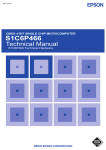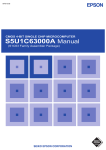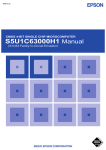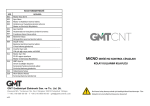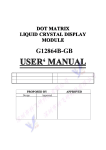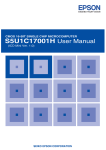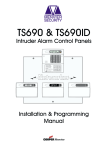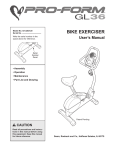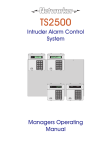Download Epson S5U1C63000H2 Specifications
Transcript
CMOS 4-BIT SINGLE CHIP MICROCOMPUTER S5U1C63000H6 Manual (S1C63 Family In-Circuit Emulator) NOTICE No part of this material may be reproduced or duplicated in any form or by any means without the written permission of Seiko Epson. Seiko Epson reserves the right to make changes to this material without notice. Seiko Epson does not assume any liability of any kind arising out of any inaccuracies contained in this material or due to its application or use in any product or circuit and, further, there is no representation that this material is applicable to products requiring high level reliability, such as medical products. Moreover, no license to any intellectual property rights is granted by implication or otherwise, and there is no representation or warranty that anything made in accordance with this material will be free from any patent or copyright infringement of a third party. This material or portions thereof may contain technology or the subject relating to strategic products under the control of the Foreign Exchange and Foreign Trade Law of Japan and may require an export license from the Ministry of Economy, Trade and Industry or other approval from another government agency. © SEIKO EPSON CORPORATION 2007, All rights reserved. Configuration of product number Devices S1 C 63158 F 0A01 00 Packing specifications 00 : Besides tape & reel 0A : TCP BL 2 directions 0B : Tape & reel BACK 0C : TCP BR 2 directions 0D : TCP BT 2 directions 0E : TCP BD 2 directions 0F : Tape & reel FRONT 0G : TCP BT 4 directions 0H : TCP BD 4 directions 0J : TCP SL 2 directions 0K : TCP SR 2 directions 0L : Tape & reel LEFT 0M : TCP ST 2 directions 0N : TCP SD 2 directions 0P : TCP ST 4 directions 0Q : TCP SD 4 directions 0R : Tape & reel RIGHT 99 : Specs not fixed Specification Package D: die form; F: QFP, B: BGA Model number Model name C: microcomputer, digital products Product classification S1: semiconductor Development tools S5U1 C 63000 A1 1 00 Packing specifications 00: standard packing Version 1: Version 1 Tool type Hx : ICE Ex : EVA board Px : Peripheral board Wx: Flash ROM writer for the microcomputer Xx : ROM writer peripheral board Cx : C compiler package Ax : Assembler package Dx : Utility tool by the model Qx : Soft simulator Corresponding model number 63000: common to S1C63 Family Tool classification C: microcomputer use Product classification S5U1: development tool for semiconductor products COnTEnTS – Contents – 1 Introduction.................................................................................................................... 1 2 S5U1C63000H6 Package ............................................................................................... 2 2.1 2.2 2.3 2.4 Components ...................................................................................................................... 2 Component Specifications ................................................................................................ 3 Environmental Condition for Operation ............................................................................. 3 Specifications of the Operation Panels ............................................................................. 4 3 Connection ..................................................................................................................... 5 3.1 3.2 3.3 3.4 AC Cable ........................................................................................................................... 5 DC Cable ........................................................................................................................... 5 Connection with Host Computer ....................................................................................... 5 Installing Peripheral Circuit Board (S5U1C63xxxP) ......................................................... 6 4 Getting Started .............................................................................................................. 7 5 Operations and Functions of the S5U1C63000H6 ...................................................... 8 5.1 Outline of Operation .......................................................................................................... 8 5.2 Break Function .................................................................................................................. 9 5.3 Monitoring Terminals ......................................................................................................... 9 5.4 Display During Execution and During Break .................................................................... 10 5.5 Break Commands ............................................................................................................ 10 5.6 Target Interrupt and Break................................................................................................ 11 5.7 Trace Function .................................................................................................................. 11 5.8 Trace Mode ....................................................................................................................... 12 5.9 Trace Trigger Point ............................................................................................................ 12 5.10 Coverage Function ......................................................................................................... 12 5.11 Measurement of Execution Time .................................................................................... 12 5.12 Self-Diagnostic Function ................................................................................................ 13 5.13 Restrictions on Emulation .............................................................................................. 13 6 lCD Driver ..................................................................................................................... 16 6.1 Differences from Actual IC ............................................................................................... 16 6.2 Connection with the Target System .................................................................................. 16 7 notes on Use................................................................................................................. 18 7.1 Notes on Operations ........................................................................................................ 18 7.2 Differences from Actual IC ............................................................................................... 18 8 Maintenance and Warranty .......................................................................................... 19 8.1 Self-Diagnostic Test.......................................................................................................... 19 8.2 Warranty ........................................................................................................................... 19 9 Troubleshooting ............................................................................................................ 20 S5U1C63000H6 Manual (S1C63 Family In-Circuit Emulator) EPSON i 1 InTRODUCTIOn 1 Introduction S5U1C63000H6 (S1C63 Family In-Circuit Emulator) is a hardware tool to effectively develop software for the S1C63 Family, 4-bit single chip microcomputers. In combination with a peripheral circuit board (S5U1C63xxxP), it provides the development environment of the software using a personal computer as a host computer, which requires Windows 2000/XP. This manual describes the operation of the S5U1C63000H6 hardware and connections of the S5U1C63000H6 system. Refer to the “S5U1C63000A Manual” for how to use the control software on the PC (debugger). Figure 1.1 shows the external view of the S5U1C63000H6. Figure 1.1 External View of S5U1C63000H6 S5U1C63000H6 Manual (S1C63 Family In-Circuit Emulator) EPSON 1 2 S5U1C63000H6 PaCKaGE 2 S5U1C63000H6 Package 2.1 Components This package is in common with all models of the S1C63 Family. After unpacking the S5U1C63000H6 package, check to see that all of the following components are included. Figure 2.1.1 shows the package structure. (1) (2) (3) (4) (5) (6) (7) (8) (9) (10) (11) (12) (13) S5U1C63000H6 (main unit) ...................................................................... 1 unit USB cable................................................................................................... 1 cable AC adapter.................................................................................................. 1 pcs. AC cable ..................................................................................................... 1 cable Jig for installing / dismounting board ........................................................ 2 pcs. S5U1C63000H6 Manual (S1C63 Family In-Circuit Emulator) ................ 1 copy (this manual) Flat cable with 50-pin × 2 connectors ........................................................ 1 pair Flat cable with 34-pin × 1 connector.......................................................... 1 pcs. 50-pin connector for target system ............................................................. 2 pcs. 34-pin connector for target system ............................................................. 1 pcs. User registration card ................................................................................. 1 pcs. Warranty card ............................................................................................. 1 pcs. Precautions on using the S5U1C63000H6 ................................................. 1 pcs. Note that the items listed below are not included in this package. These items need to be provided separately. (14) S5U1C63xxxP Board (included in the S5U1C63xxxP package) (15) S5U1C63xxxP Manual (included in the technical manual for each models) (16) S1C63 Family Debugger (included in the S1C63 Family Assembler package) (17) S5U1C63000A Manual (included in the S1C63 Family Assembler package) • S5U1C63000H6 Manual EPSON EPSON S5U1C63000H2 Manual • User registration card • Warranty card • Precautions on using the S5U1C63000H6 Registration .............. .......... ............ ........ S5U1C63000H2 Manual English Japanese Registration .............. .......... ............ ........ English Japanese OFF ON DIAG LC2 LC1 TR G ST OU OP T O TR UT C BR IN K IN G N D PO W ER SL EM P/H U LT • S5U1C63000H6 main unit S5U1C63000H6 • AC adapter EPSOn • Connectors for target system (50-pin × 2) (34-pin × 1) • AC cable • USB cable • Jigs • Flat cables (50-pin × 2) (× 2) (34-pin × 1) Figure 2.1.1 S5U1C63000H6 Package Structure 2 EPSON S5U1C63000H6 Manual (S1C63 Family In-Circuit Emulator) 2 S5U1C63000H6 PaCKaGE 2.2 Component Specifications Table 2.2.1 shows the specifications of the component in the S5U1C63000H6 package. Table 2.2.1 Specifications of S5U1C63000H6 Components no. 1 Components S5U1C63000H6 (main unit) Items Dimensions Weight External color Input voltage Power consumption Board mounted 2 Interface cable Length 3 AC adapter Dimensions Input voltage Input frequency Power consumption Output voltage, Current Length Plug type Jig 4 AC cable 5 Accessories User connector 6 Package Hardware manual Warranty card, User registration card Dimension Materials Specifications 282 mm (W) × 177 mm (D) × 70 mm (H) Approx. 1.8 kg (main body) Approx. 3.5 kg (total weight of package) Cygnus white DC 12 V 3 A, max. Main board (included LCD driver) 1 board USB cable: 1.5 m LCD cable: 0.4 m 100 mm (W) × 60 mm (D) × 30 mm (H) AC 90 V to 264 V 50 Hz to 60 Hz ±3 Hz 36 W, max. (in main system load) DC 12 V, 3 A, with over current protection 1.8 m 2-pin For installing/dismounting option boards 2 pcs. 3431-6002-LCPL (3M): 1 pcs. 3433-6002-LCPL (3M): 2 pcs. Remarks Rubber feet included Peripheral circuit board is sold separately. Outside: 0 V Inside: 12 V 380 mm (W) × 260 mm (D) × 225 mm (H) W carton, cardboard 2.3 Environmental Condition for Operation Table 2.3.1 shows the environmental conditions to operate S5U1C63000H6 that has to be used. Table 2.3.1 Environmental Conditions no. 1 2 3 4 5 Items Operating temperature Storage temperature Operation humidity Storage humidity Resistance to vibration S5U1C63000H6 Manual (S1C63 Family In-Circuit Emulator) Specifications 5 to 40°C -10 to 60°C 35 to 80% 20 to 90% Operating: Transportation: EPSON Remarks No condensation 0.25 m/s2 1 m/s2 3 2 S5U1C63000H6 PaCKaGE 2.4 Specifications of the Operation Panels OFF ON DIAG LC2 TR G ST OU OP T O TR UT C BR IN K IN G N D PO W ER SL EM P/ U H LT Figure 2.4.1 shows the external view of the panels. LC1 S5U1C63000H6 EPSOn (Front view) POWER DC 12V FG CB O I (Rear view) Figure 2.4.1 External View of S5U1C63000H6 Panels Table 2.4.1 shows the function of each component on the panels. Table 2.4.1 Function List of Components no. 1 2 3 Position Symbol name Function Front panel POWER Front panel EMU Front panel SLP/HLT Power on LED This green LED lights upon power-on of the S5U1C63000H6. Emulation LED This red LED lights when the target program is in running status. SLEEP/HALT LED This yellow LED lights when the S1C63000 CPU executes the HALT or SLP instruction. This LED also lights when the peripheral circuit board has not been installed. 4 Front panel DIAG Self-diagnostic This switch is used to select whether the S5U1C63000H6 selfselect switch diagnosis at startup of the debugger will be executed or not. 5 Front panel TRGOUT Trace-trigger Upon coincidence of trigger conditions with a tracing trigger point, output terminal a pulse is output from this terminal. 6 Front panel STOPOUT SLEEP/HALT When the S1C63000 CPU is in HALT or SLEEP status, a low level status output signal is output from this terminal. This is used to measure executerminal tion rate of the CPU. Also this terminal goes low in break status. 7 Front panel TRCIN Trace input Trace information will be stored in the trace memory by connecting terminal a signal of the target system to this terminal. 8 Front panel BRKIN Break input A running program enters break status by input a low level signal terminal to this terminal from the target system. 9 Front panel GND Ground terminal When monitoring the above terminals with an oscilloscope, connect the GND line of the oscilloscope to this terminal. This is also used as a GND when inputting signals to the above terminals. 10 Front panel LC1, LC2 LCD connectors These connectors are used to connect an LCD panel. 11 Rear panel POWER Power switch Turns the S5U1C63000H6 power on and off. 12 Rear panel DC12V DC input connector This connector is used to connect the DC cable of the AC adapter for S5U1C63000H6. Be sure to use the AC adapter included in this package. 13 Rear panel CB Circuit breaker The breaker cuts off the power of this system (peripheral board, add-on board and target board) at consumption current of 3 A or more. A small staff of breaker comes up at the shut-off. The staff should be at the recessed position for normal operating status. 14 Rear panel USB connector This USB cable connector is used to interface with the host computer. 15 Rear panel FG Frame ground This is the frame ground terminal. We recommend to connect this terminal to the ground line. 4 EPSON S5U1C63000H6 Manual (S1C63 Family In-Circuit Emulator) 3 COnnECTIOn 3 Connection This chapter describes the connection between S5U1C63000H6 and a host computer and a Peripheral Circuit Board (S5U1C63xxxP). 3.1 aC Cable The S5U1C63000H6 package includes a dedicated AC cable (with 2-pin plug) and AC adapter. The AC cable is connected into the AC inlet on the AC adapter. Host computer S5U1C63000H6 DC 12V POWER FG CB DC 12V FG AC adapter dedicated for S5U1C63000H6 DC cable AC inlet AC cable AC line Frame ground line * We recommend to connect between the FG terminal of the S5U1C63000H6 and a frame ground. Figure 3.1.1 Connection of AC Line 3.2 DC Cable Connect the DC output cable of the AC adapter to the DC12V connector located at the S5U1C63000H6 rear panel. 3.3 Connecting with Host Computer Connect between the host computer and the S5U1C63000H6 using the USB cable included in this package. Host computer S5U1C63000H6 USB DC 12V POWER CB FG USB connector Figure 3.3.1 Connecting with Host Computer S5U1C63000H6 Manual (S1C63 Family In-Circuit Emulator) EPSON 5 3 COnnECTIOn 3.4 Installing Peripheral Circuit Board (S5U1C63xxxP) By installing the S5U1C63xxxP peripheral circuit board (to be separately sold) into a slot of the S5U1C63000H6, a debug system can be made corresponding to each device of the S1C63 Family. Figure 3.4.1 shows installing method of the peripheral circuit board. The S5U1C63000H6 is equipped with an LCD driver function, so an LCD board is not required. (1), (4) (2) LC1 LC2 6 63000H S5U1C DIAG OFF ON Peripheral circuit board (2), (3) Figure 3.4.1 Installing Peripheral Circuit Board (1) Unfasten the screws located on the left and right sides of the front panel of the S5U1C63000H6 by turning them counterclockwise then remove the front panel. (2) Insert the peripheral circuit board into the slot and push it using the jig attached with the S5U1C63000H6 as shown in Figure 3.4.2. Using this jig as a lever, push it toward the inside of the board evenly on the left and right sides. After confirming that the peripheral circuit board has been firmly fitted into the internal slot of the S5U1C63000H6, remove the jig. Peripheral circuit board Figure 3.4.2 Installing Peripheral Circuit Board (3) When dismounting the peripheral circuit board, set the jig into position as shown in Figure 3.4.3. Using this jig as a lever, push it toward the outside of the board evenly on the left and right sides and pull the peripheral circuit board out of the S5U1C63000H6. Peripheral circuit board (4) Mounting the front panel removed at the step (1) on the main case by pushing and turning two screws located at both side. Figure 3.4.3 Dismounting Peripheral Circuit Board (5) The jig has a magnet for keeping under the bottom plate of the case while not in use. 6 EPSON S5U1C63000H6 Manual (S1C63 Family In-Circuit Emulator) 4 GETTInG STaRTED 4 Getting Started The S5U1C63000H6 can start using the debugger software after connecting to the host computer. (1) Setting the DIaG switch The S5U1C63000H6 has a self-diagnostic function at power-on. When using this function, set the DIAG switch to ON. To skip the diagnosis, set the switch to OFF. See Section 5.12, “Self-Diagnostic Function,” for more information on the self-diagnostic function. (2) Turning the S5U1C63000H6 on Turn the power switch on. The power LED (green) lights. The SLP/HLT LED (yellow) lights momentarily and goes out. (3) Starting the debugger Launch the debugger on the host computer. The SLP/HLT LED (yellow) lights momentarily and goes out. (4) Executing the target program Execute the target program from the debugger. When the target program starts running, the EMU LED (red) lights to indicate that the S5U1C63000H6 enters emulation mode. When the SLP or HALT instruction is executed, the SLP/HLT LED (yellow) lights. (5) When a break occurs When the target program stops at the break point set with the debugger, the EMU LED (red) goes out. S5U1C63000H6 Manual (S1C63 Family In-Circuit Emulator) EPSON 7 5 OPERaTIOnS anD FUnCTIOnS OF THE S5U1C63000H6 5 Operations and Functions of the S5U1C63000H6 This chapter describes operations, functions in detail and restrictions in the emulation mode of the S5U1C63000H6. 5.1 Outline of Operation ICE control processor ICE firmware Emulation control portion Emulation program memory Emulation data memory S1C63000 CPU Trace control unit Break control unit Target monitor unit To peripheral circuit board Figure 5.1.1 Function Block Diagram of the S5U1C63000H6 The S5U1C63000H6 has a processor to control in-circuit emulation, which processes the commands. The function to execute or stop target programs by the S1C63000 CPU is called emulation, and it is controlled by the emulation control unit. The operating mode while the S1C63000 CPU is running (specified by the G command) or single stepping (specified by the S or N command) is called emulation mode. The EMU LED lights in this mode. The other status is called standby mode in which the EMU LED goes out. The target program to be executed with the S1C63000 CPU is stored in the emulation program memory and data RAM area of the S1C63000 CPU is assigned to the emulation data memory. In the standby mode, the S5U1C63000H6 control processor loads the program from the host computer. The trace control unit consists of a memory of 8,192 words × 120 bits and records execution bus cycles of the S1C63000 CPU. The memory enables the register value inside the S1C63000 CPU to be real timely recorded. The program execution is traced in the emulation mode and the traced information is analyzed by the S5U1C63000H6 control processor in the standby mode. The break control unit compares the bus condition of the S1C63000 CPU with break points and stops the execution of the target program upon coincident. The break can be also real timely made by register values of the S1C63000 CPU. While the target program is running, the S5U1C63000H6 control processor monitors the executed program counter value of the S1C63000 CPU and RAM contents at watching points via the target monitor unit. The monitored results are displayed as on-the-fly information. The S1C63000 CPU can real timely execute the target program while the information is displayed. 8 EPSON S5U1C63000H6 Manual (S1C63 Family In-Circuit Emulator) 5 OPERaTIOnS anD FUnCTIOnS OF THE S5U1C63000H6 5.2 Break Function (1) Forced break The debugger on the host computer can forced break the emulation. This function is useful when the program counter does not proceed by executing the SLP or HALT instruction in a single step process. (2) Break commands Some break commands are available to set various breaking condition. A break occurs when the break condition specified by the command and status of the S1C63000 CPU are met. (3) Break by accessing to undefined area This break occurs when the target program accesses an address exceeding the ROM capacity of the actual chip. The break is also occurred when any address other than the RAM area or mapped I/O area of the actual chip is accessed. (4) Break by accessing write protect area This break occurs when the target program writes data to the read only memory such as a character generator ROM. The memory contents are protected even if this break occurs. (5) Break by incorrect stack accessing This break occurs when the target program makes incorrectly stacking operation exceeding the defined stack area in the S1C63000 CPU. (6) BRKIn terminal When a signal is input to the BRKIN terminal, a break occurs at the falling edge of the signal. 5.3 Monitoring Terminals (1) TRGOUT output terminal A low level pulse is output at the T3 state of the clock when the trace trigger condition and the bus cycle are met. T1 CLK from peripheral circuit board T2 T3 T4 PK PL Bus cycle Coincidence with trace trigger TRGOUT output Figure 5.3.1 TRGOUT Terminal Output (2) STOPOUT output terminal This terminal goes low when the S1C63000 CPU is suspended (by executing of the HALT or SLP instruction). This terminal also outputs low level during a break. STOPOUT output Indicating suspension of CPU operation Running Breaking Figure 5.3.2 STOPOUT Terminal Output S5U1C63000H6 Manual (S1C63 Family In-Circuit Emulator) EPSON 9 5 OPERaTIOnS anD FUnCTIOnS OF THE S5U1C63000H6 (3) TRnIn input terminal By connecting a signal line of the target system to this terminal, the signal status is stores in the trace memory as a trace information. “1” is written to the trace memory when no signal is connected or the signal goes high, or “0” is written when the signal goes low. The signal level is sampled at the rising edge of T4 state. (4) BRKIn input terminal A break occurs when a low level signal is input to this terminal while the target program is running. To use this terminal for the break function, the low level pulse must be 20 ms or longer. By connecting the TRGOUT output terminal to the BRKIN input terminal, breaks can be occurred according to the trace trigger conditions. Note: The above output terminals outputs 5.0 V. The input terminals have a pull-up resistor and allow input of a signal within 3.3 V to 5.0 V. 5.4 Display During Execution and During Break The S5U1C63000H6 control processor monitors the execution status of the S1C63000 CPU while the target program is running. It displays the S1C63000 CPU’s execution status in every 500 ms when the on-the-fly display mode is specified. The program counter value that is displayed during break shows the address to be executed in the next step. The register contents displayed are the values when the previous break occurred. 5.5 Break Commands The S5U1C63000H6 has abundant break functions. (1) Program counter break This break function is specified by the BP command. When the program counter of the S1C63000 CPU coincides with the specified address, a break occurs before executing the instruction. Multiple program counter values (up to maximum size of program memory) can be specified as break points. (2) Program counter sequential break This break function is specified by the BS command. A break occurs when the program counter of the S1C63000 CPU counts three addresses in the specified order. The pass counter can be specified for the last address. The sequence (address 1 coincidence) → (address 2 coincidence) → (address 3 counted by specified times) breaks the execution. (3) Break by data access This break function is specified by the BD command. A break occurs immediately after the target program accesses the data memory in the specified condition (address, data and read or write operation). It is possible to specify a range for the address condition, a mask in bit units for the data condition and a mask for the read/ write condition. This specification can set one break point only. (4) Break by register value This break function is specified by the BR command. When the register values of the S1C63000 CPU coincide with the specified values, a break occurs immediately after the instruction is executed. A/B register, E/I/C/Z flag and X/Y register values can be specified as a break condition. It is also possible to specify masking on each register. This specification can set one break point only. The above break functions (1, 2, 3 and 4) can be independently specified. When the target program is executed with all the BP, BS, BD and BR commands specified, a break occurs by meeting any condition. 10 EPSON S5U1C63000H6 Manual (S1C63 Family In-Circuit Emulator) 5 OPERaTIOnS anD FUnCTIOnS OF THE S5U1C63000H6 5.6 Target Interrupt and Break When an interrupt in the target program and a break are simultaneously occurred, the target interrupt is prioritized. The break occurs after completing the stack operation of the interrupt. The program counter at the break shows the top address of the interrupt handler routine. When the target program is restarted, it executes from the top address of the interrupt handler routine. If an interrupt and a break are simultaneously occurred when “I” (interrupt flag) = “1” is set as a break condition by BR command, a break occurs when the “I” flag goes “1.” However, the flags after the break occurred are displayed as “EICZ: 0000” (the “I” flag is reset) because of the prioritized interrupt process. 5.7 Trace Function During running in emulation mode, information of the S1C63000 CPU (program counter, instruction code, data RAM address, data content and CPU register values) is stored into the trace memory at every CPU bus cycle. The trace memory has a capacity of 8,192 cycles, which can store the latest instructions up to 4,096 in 2 bus-cycle instruction and 2,048 in 4 bus-cycle instruction. Trace memory Trace memory Earliest instruction (TP = 0) Effective trace Effective trace Execution of a program Instruction just before break (TP = 700) (TP = 8,191) Instruction just before break Earliest instruction (TP = 0) Effective trace Free space Figure 5.7.1 Trace Function Figure 5.7.1 shows the trace function. When the trace memory becomes full, old information is erased and new information is overwritten. TP, which is called trace pointer, shows that the point of 0 means the earliest instruction and the break point means the latest information. The maximum value of the TP is 8,191. Trace information TP = 0 Earliest instruction Trace information at any point can be displayed by the TD command. TP = 8,191 Latest instruction Figure 5.7.2 Trace Pointer S5U1C63000H6 Manual (S1C63 Family In-Circuit Emulator) EPSON 11 5 OPERaTIOnS anD FUnCTIOnS OF THE S5U1C63000H6 5.8 Trace Mode There are following three trace modes available in the S5U1C63000H6. (1) all bus cycle trace mode In this trace mode, all bus cycles are traced during run emulation and step emulation until a break occurs. (2) Specified program counter range trace mode In this mode, bus cycles within the specified range (or outside the specified range) are traced during run emulation and step emulation until a break occurs. This function is useful for cases of tracing objective work data only or removing an WAIT routine from the trace. (3) Single delay trigger In this mode, starting a run emulation starts tracing for all bus cycles. When the emulation hit the trace trigger condition, the trace continues for the specified number of bus cycles, and then it stops. The trace information is displayed after a break occurs. In the debugger, one of the above modes can be selected by the TM command. 5.9 Trace Trigger Point In the S5U1C63000H6, a trace trigger point can be specified independent of break points. The trace trigger point is specified as the program counter conditions of the S1C63000 CPU. A low level pulse is output from the TRGOUT terminal with the timing of T3 upon coincidence of the specified value and the program counter. The information of the trace trigger point is also stored into the trace memory. In the single delay trigger mode, the trace trigger point becomes a condition for stopping the trace. 5.10 Coverage Function The S5U1C63000H6 can retrieve and display the address information of the program accessed at the execution. The confirmation of portions whether failure analysis or debugging is completed or not can be done by checking the program through reference of the coverage information after running the program for a long time. This function is specified by the CV or CVC command. 5.11 Measurement of Execution Time The S5U1C63000H6 has a function to measure the time from start to break of the target program or to count the number of bus cycles. This function is set by the MD command. (1) Time measurement mode • Range of time measurement 1 µs to 1*(231-1) µs (≈ 2,147 seconds ≈ 36 minutes) • Measurement error ±1 µs • Units of time display Micro second (µs) units (2) Bus cycle count mode • Range of cycle measurement 1 bus cycle to (231-1) bus cycles (= 2*109 bus cycles) • Measurement error 0 cycles 12 EPSON S5U1C63000H6 Manual (S1C63 Family In-Circuit Emulator) 5 OPERaTIOnS anD FUnCTIOnS OF THE S5U1C63000H6 5.12 Self-Diagnostic Function The S5U1C6300H6 allows selection whether the self-diagnostic check at power on is performed or not. (1) Disabling self-diagnostic mode (DIaG switch: OFF) When the DIAG switch on the S5U1C63000H6 front panel is set to OFF, the S5U1C63000H6 becomes ready to accept commands without the self-diagnostic check after power on. (2) Enabling self-diagnostic mode (DIaG switch: On) When the DIAG switch is set to ON, the S5U1C63000H6 executes the self-diagnostic check shown below after power on, and then it becomes ready to accept commands. (a) ROM test Tests the check-sum of the firmware. (b) RAM test Performs the read/write test of the RAM in the S5U1C63000H6. (c) Emulation test Tests if a break occurs normally by executing a run emulation for a few steps of instructions on the emulation memory. When the debugger is started up after the S5U1C63000H6 is turned on with the self-diagnostic mode enabled, the S5U1C63000H6 performs diagnosis for about one minute. After that, the debugger enters command waiting status. 5.13 Restrictions on Emulation (1) Timer operation in standby mode In the emulation with a peripheral circuit board connected to the S5U1C63000H6, the S1C63000 CPU ordinarily idles (standby mode) as shown in Section 5.1. In the standby mode, the S5U1C63000H6 executes the monitor program and the peripheral circuit board is in stop status. The S5U1C63000H6 executes the target program by the G command and returns to the monitor program after a break occurs. S1C63000 CPU operation Monitor program is running (standby mode) Target program is running (emulation mode) Monitor program is running (standby mode) Figure 5.13.1 Operation of S1C63000 CPU In the models with a built-in timer or watchdog timer, the timer runs only when the target program is executed if the timer is enabled. Therefore, in the single step operation, the S1C63xxx timer cannot count in real time. (2) Interrupt in standby mode In the standby mode, interrupt requests from the target system is reserved. The interrupt while the monitor program is being executed is accepted at the execution of the target program. For instance, when an interrupt request from the target system is generated while breaking, the interrupt will be accepted immediately after the target program restarts if the interrupt is enabled in the S1C63000 CPU. S5U1C63000H6 Manual (S1C63 Family In-Circuit Emulator) EPSON 13 5 OPERaTIOnS anD FUnCTIOnS OF THE S5U1C63000H6 (3) Interrupt at single step operation Interrupts during single step operation can be enabled or disable using the MD command. Each operation is as follows. When interrupt is enabled If an interrupt request is generated while the target program is single stepping by the S or N command, the interrupt processing will be started when an instruction is executed, and the execution stops after fetching the vector address of the interrupt. Therefore, the next single step operation executes the interrupt handler routine. When the HALT or SLP instruction is executed by the S or N command, the execution is not terminated until an interrupt occurs. In this status, a forced break input from the host computer can suspend the execution. When interrupt is disabled An interrupt processing is not executed by the S command. Therefore, the execution of the HALT or SLP instruction is immediately suspended, and the program counter indicates the address next to the HALT or SLP instruction. The N command operates similar to the S command in the execution of the main routine. However, it enables interrupts while a sub routine is being executed regardless of whether the MD command enables interrupts or not. (4) Data read from undefined RaM area When a data RAM (ROM) area or an I/O area that is not available in the actual IC chip is read, the read data becomes indefinite. Read data from the actual IC is also indefinite, however it is different from the S5U1C63000H6. (5) Detection of SP1 incorrect stack access It is possible to detect any incorrect stack access to out of the SP1 area by specifying the SP1 area with the BSP command. The S1C63000 CPU has a queue register and takes stack values in advance in order to make high speed process of the stacking operation for the CALR instruction and interrupts. Therefore, when restoring a value from the top address of the stack, the S1C63000 CPU takes a value beyond the top address and writes it into the queue register. This operation works without any problem. However, the queue register has an indefinite value. In order not to make this process incorrect access, add three to the top address of the SP1 area when specifying. (6) Data read break Executing the “INT addr6” instruction issues a dummy read cycle for the memory specified with the addr6 operand. Therefore, a break caused by the dummy read will occur at this instruction when a data read break condition has been specified by the BD command. 14 EPSON S5U1C63000H6 Manual (S1C63 Family In-Circuit Emulator) 5 OPERaTIOnS anD FUnCTIOnS OF THE S5U1C63000H6 (7) Register (data) break The register (data) value after a break occurs may differ from the value set as a register (data) break condition. The following shows an example if a break condition has been set so that a break will occur when the A register is set to 5, and when the S1C63000 CPU has executed the sequence in the timing chart shown below to set the A register to 5 and 6: CLK Instruction execution ld %a, 5 A register ICE data judgment point <1> ld %a, 6 ICE monitor command ICE monitor command 5 6 <2> <3> Figure 5.13.2 Example of Register Break The S5U1C63000H6 judges the register data at the points indicated with a “↑.” It judges that the A register is “5” at the point of <2>, and the register break condition is met at the same time. However, the S1C63000 CPU is executing the following “ld %a, 6” instruction at this point and the break occurs after the A register is set to “6.” Therefore, “6” is read from the A register after the break has occurred. This is also applied to the break by accessing to undefined area function. (8) Register (data) break and hardware interrupt If a hardware interrupt occurs when the register (data) break condition described in Item (7) is met, register (data) break will occur at the top address of the interrupt handler routine. The following shows an example when a hardware interrupt factor occurs while the S1C63000 CPU is executing the sequence in the timing chart shown below to set the A register to 5 and 6, if a break condition has been set so that a register break will occur when the A register is set to 5: CLK Instruction execution ld %a, 5 A register ld %a, 6 5 6 <2> <3> Interrupt factor IACK ICE data judgment point <1> Figure 5.13.3 Example When a Register Break and an Interrupt Occur Simultaneously In the timing chart above, if an interrupt factor occurs (falling edge) at the point of <1>, the S1C63000 CPU outputs the IACK signal to indicate that an interrupt acknowledgment cycle is executed. The interrupt processing cannot be stopped while IACK is at low level. Therefore, the S5U1C63000H6 cannot disable the interrupt even if the register break condition (A register = “5”) is met at the point of <2>, as IACK is at low level. The register break will occur after jumping to the interrupt vector address. S5U1C63000H6 Manual (S1C63 Family In-Circuit Emulator) EPSON 15 6 lCD DRIVER 6 LCD Driver The S5U1C63000H6 has an LCD driver for emulating built-in LCD driver models. Note, however, that some functions supported with the S5U1C63000H6 may not be available in the model to be used. For details of the LCD driver functions, refer to the technical manual for each model. 6.1 Differences from actual IC Be aware that there are differences on the functions and characteristics from those of the actual IC as shown below. If they are not taken into consideration, the program may not be operated properly on the actual IC even if there is no problem on the S5U1C63000H6 with the LCD diver. (1) Initialization In the actual IC, contents of the LCD segment memory are indefinite at system reset and the output LCD drive waveform is also indefinite according to the memory contents. It means that the segment memory and the LCD drive waveforms are coincident even though both are indefinite. However, in the S5U1C63000H6, the segment memory and the output LCD drive waveform are not coincident. Therefore, be sure to create the initial routine so that the LCD segment memory will be cleared (or set) after a system reset. (2) lCD segment RaM (for models in which the memory-bit assignment for the LCD segments is fixed) In the actual IC, when reading a segment memory address that contains both the bits assigned for the LCD segments and the bits not assigned, the unassigned bits are always read as “0.” However, in the S5U1C63000H6, the unassigned bits in the segment memory can be read and written as memory bits. Therefore, the program must ignore these unassigned bit values when a segment memory word is read out. (3) Drive capability of SEG and COM terminals The output drive capability of the SEG and COM terminals in the S5U1C63000H6 is different from that of the actual IC. The S5U1C6300H6 cannot be used for evaluating electrical characteristics. The system should be designed in consideration of the electrical characteristics described in the technical manual of each model. (4) lCD dive voltage The LCD drive voltage in the S5U1C63000H6 may differ from that of the actual IC. 6.2 Connection with the Target System Use the supplied connection cables (100-pin/50-pin × 2 flat type, 34-pin flat type) to connect between the S5U1C63000H6 and the LCD connectors on the target board. mark Connection cable mark CN4-1 (50-pin) CN4-2 (50-pin) CN5 (34-pin) To target board Figure 6.2.1 Connecting with the Target System 16 EPSON S5U1C63000H6 Manual (S1C63 Family In-Circuit Emulator) 6 lCD DRIVER Connector pin assignments Table 6.2.1 LC1 Connector (100-pin/50-pin × 2 flat type) lC1 connector (Cn4-1) no. Signal name lC1 connector (Cn4-2) no. Signal name 1 2 3 4 5 6 7 8 9 10 11 12 13 14 15 16 17 18 19 20 21 22 23 24 25 26 27 28 29 30 31 32 33 34 35 36 37 38 39 40 41 42 43 44 45 46 47 48 49 50 1 2 3 4 5 6 7 8 9 10 11 12 13 14 15 16 17 18 19 20 21 22 23 24 25 26 27 28 29 30 31 32 33 34 35 36 37 38 39 40 41 42 43 44 45 46 47 48 49 50 COM0 COM1 COM2 COM3 COM4 COM5 COM6 COM7 SEG0 SEG1 SEG2 SEG3 SEG4 SEG5 SEG6 SEG7 SEG8 SEG9 SEG10 SEG11 SEG12 SEG13 SEG14 SEG15 SEG16 SEG17 SEG18 SEG19 SEG20 SEG21 SEG22 SEG23 SEG24 SEG25 SEG26 SEG27 SEG28 SEG29 SEG30 SEG31 SEG32 SEG33 SEG34 SEG35 SEG36 SEG37 SEG38 SEG39 SEG40 SEG41 S5U1C63000H6 Manual (S1C63 Family In-Circuit Emulator) SEG42 SEG43 SEG44 SEG45 SEG46 SEG47 SEG48 SEG49 SEG50 SEG51 SEG52 SEG53 SEG54 SEG55 SEG56 SEG57 SEG58 SEG59 SEG60 SEG61 SEG62 SEG63 SEG64 SEG65 SEG66 SEG67 SEG68 SEG69 SEG70 SEG71 SEG72 SEG73 SEG74 SEG75 SEG76 SEG77 SEG78 SEG79 Cannot be connected Cannot be connected Cannot be connected Cannot be connected Cannot be connected Cannot be connected Cannot be connected Cannot be connected Cannot be connected Cannot be connected Cannot be connected Cannot be connected EPSON Table 6.2.2 LC2 Connector (34-pin flat type) no. 1 2 3 4 5 6 7 8 9 10 11 12 13 14 15 16 17 18 19 20 21 22 23 24 25 26 27 28 29 30 31 32 33 34 lC2 connector (Cn5) Signal name COM0 COM1 COM2 COM3 COM4 COM5 COM6 COM7 COM8 COM9 COM10 COM11 COM12 COM13 COM14 COM15 COM16 COM17 COM18 COM19 COM20 COM21 COM22 COM23 COM24 COM25 COM26 COM27 COM28 COM29 COM30 COM31 Cannot be connected Cannot be connected Note that some signals do not exist in the actual IC depending on the model. The COM0–COM7 pins are available in the both connectors CN4-1 and CN5, and either one can be used. 17 7 nOTES On USE 7 Notes on Use Pay attention to the following matters for proper use of the S5U1C63000H6. 7.1 notes on Operations (1) Connecting and disconnecting the units Make sure that the S5U1C63000H6 is turned off when installing the peripheral circuit board (S5U1C63xxxP) and connecting/disconnecting the cables, as hot insertion/removal may damage the IC. (2) Turning power on and off When turning the S5U1C63000H6 off and on again, wait at least 10 seconds before turning on. If power is turned on without an interval, the power-on-reset sequence may not be executed normally and the result is that the S5U1C63000H6 fails to function normally, or the circuit breaker on the S5U1C63000H6 may trip. (3) Peripheral circuit board (S5U1C63xxxP) A peripheral circuit board is required to operate the S5U1C63000H6. The S5U1C63000H6 package does not include a peripheral circuit board, so it must be prepared separately. If the S5U1C63000H6 is turned on without a peripheral circuit board installed, the “SLP/HLT” LED on the S5U1C63000H6 front panel lights. (4) Over current protection If the S5U1C63000H6 is turned on when VDD and VSS are short-circuited on the target system, the over current protection function of the dedicated AC adapter works to cut off its output current and the power LED does not light. The circuit breaker cuts the power at the load current of 3 A or more on the target system. 7.2 Differences from actual IC (1) Initialization of RaM The data RAM of the actual IC is not initialized at system reset, however, the S5U1C63000H6 initializes the RAM with “0A.” Therefore, be sure to initialize the RAM in the target program, and do not create a program depending on the initial value. (2) Initialization of registers In the actual IC, the CPU registers are not initialized at power on. At initial reset, they keep values prior to the reset expect the program counter (PC), the interrupt flag (I) and the extension flag (E). However, the CPU registers in the S5U1C63000H6 are initialized to “0A” (4-bit), “0AA” (8-bit) and “0AAAA” (16-bit) at the power on and at a software reset by the debugger command. Therefore, be sure to initialize the registers, and do not create a program depending on the initial value. The reset switch on the peripheral circuit board and the hardware reset input from the I/O connector keep values prior to the reset the same as the actual IC. (3) access to undefined area In the S5U1C63000H6, a break occurs if an undefined area is accessed. However, a RAM is included in the undefined area and an undefined area break occurs after the area has been accessed, so any data can be written to the undefined area. When the target program is restarted after an undefined area break has occurred, it works using a memory area that does not exists in the actual IC. Therefore, be sure to avoid reading/writing from/to undefined area by the target program. (4) Data dump The S5U1C63000H6 uses a peripheral circuit board clock for accessing a RAM, ROM, LCD or I/O area with a data dump command. Therefore, the value of the I/O area read in the target program may differ from the value read by a dump command, when an I/O area that develops a delay until the correct value is obtained due to the parasitic capacitance and the pull-up/down resistor of the I/O terminal. 18 EPSON S5U1C63000H6 Manual (S1C63 Family In-Circuit Emulator) 8 MaInTEnanCE anD WaRRanTY 8 Maintenance and Warranty 8.1 Self-Diagnostic Test The self-diagnostic test is executed by starting the debugger after setting the DIAG switch on the front panel to “ON” position and then turning the S5U1C63000H6 on. The debugger displays the messages shown below during the start-up sequence. Debugger for S1C63 Ver. x.xx Copyright (C) SEIKO EPSON CORP. 1998-xxxx Connecting USB ... done DIAG test, please wait 1 min ... done ← <1> Parameter file name : Par63xxx.par Version : xx Chip name : xxxxx CPU version : x.x PRC board version : x.x LCD board version : x.x EXT board version : x.x ICE hardware version : x.x ICE software version : x.x DIAG test : OK. Map ............................. done Initialize ...................... done > When an error is detected in the diagnosis, the error message is displayed at the point <1> instead of “done.” If an error message is displayed, stop using the S5U1C63000H6, as it may have a hardware failure. This self-diagnostic test takes about one minute for its precise inspection until it is completed and the S5U1C63000H6 is ready to accept commands. 8.2 Warranty Please refer to the warranty card included in the package for the warranty details. S5U1C63000H6 Manual (S1C63 Family In-Circuit Emulator) EPSON 19 9 TROUBlESHOOTInG 9 Troubleshooting Following shows some hardware errors and their possible causes. (1) a message of “connecting USB ... failure” is displayed at start-up of the debugger. • Is power of the S5U1C63000H6 on? • Is the circuit breaker (CB) off? • Is the host cable connected correctly? • Is the target cable connected correctly? • Is the peripheral circuit board insert firmly? (2) The circuit breaker (CB) trips and the POWER lED goes out when the S5U1C63000H6 is turned on. • Is the target cable connected correctly? • Is VDD and VSS short-circuited on the target board? Refer to the “S5U1C63000A Manual” for operations of the debugger. 20 EPSON S5U1C63000H6 Manual (S1C63 Family In-Circuit Emulator) International Sales Operations AMERICA ASIA EPSON ELECTRONICS AMERICA, INC. EPSON (CHINA) CO., LTD. 23F, Beijing Silver Tower 2# North RD DongSanHuan ChaoYang District, Beijing, CHINA Phone: +86-10-6410-6655 Fax: +86-10-6410-7320 HEADQUARTERS 2580 Orchard Parkway San Jose, CA 95131, U.S.A. Phone: +1-800-228-3964 Fax: +1-408-922-0238 SALES OFFICE Northeast 301 Edgewater Place, Suite 210 Wakefield, MA 01880, U.S.A. Phone: +1-800-922-7667 Fax: +1-781-246-5443 EUROPE EPSON EUROPE ELECTRONICS GmbH HEADQUARTERS Riesstrasse 15 80992 Munich, GERMANY Phone: +49-89-14005-0 Fax: +49-89-14005-110 SHANGHAI BRANCH 7F, High-Tech Bldg., 900, Yishan Road Shanghai 200233, CHINA Phone: +86-21-5423-5522 Fax: +86-21-5423-5512 EPSON HONG KONG LTD. 20/F, Harbour Centre, 25 Harbour Road Wanchai, Hong Kong Phone: +852-2585-4600 Fax: +852-2827-4346 Telex: 65542 EPSCO HX EPSON Electronic Technology Development (Shenzhen) LTD. 12/F, Dawning Mansion, Keji South 12th Road Hi- Tech Park, Shenzhen Phone: +86-755-2699-3828 Fax: +86-755-2699-3838 EPSON TAIWAN TECHNOLOGY & TRADING LTD. 14F, No. 7, Song Ren Road Taipei 110 Phone: +886-2-8786-6688 Fax: +886-2-8786-6660 EPSON SINGAPORE PTE., LTD. 1 HarbourFront Place #03-02 HarbourFront Tower One, Singapore 098633 Phone: +65-6586-5500 Fax: +65-6271-3182 SEIKO EPSON CORPORATION KOREA OFFICE 50F, KLI 63 Bldg., 60 Yoido-dong Youngdeungpo-Ku, Seoul, 150-763, KOREA Phone: +82-2-784-6027 Fax: +82-2-767-3677 GUMI OFFICE 2F, Grand B/D, 457-4 Songjeong-dong Gumi-City, KOREA Phone: +82-54-454-6027 Fax: +82-54-454-6093 SEIKO EPSON CORPORATION SEMICONDUCTOR OPERATIONS DIVISION IC Sales Dept. IC International Sales Group 421-8, Hino, Hino-shi, Tokyo 191-8501, JAPAN Phone: +81-42-587-5814 Fax: +81-42-587-5117 S5U1C63000H6 Manual (S1C63 Family In-Circuit Emulator) SEMICONDUCTOR OPERATIONS DIVISION EPSON Electronic Devices Website http://www.epson.jp/device/semicon_e Document code: 411189600 Issue September, 2007 Printed in Japan L A




























